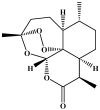Assessment of Artemisinin Contents in Selected Artemisia Species from Tajikistan (Central Asia)
- PMID: 30709043
- PMCID: PMC6473495
- DOI: 10.3390/medicines6010023
Assessment of Artemisinin Contents in Selected Artemisia Species from Tajikistan (Central Asia)
Abstract
Background: Central Asia is the center of origin and diversification of the Artemisia genus. The genus Artemisia is known to possess a rich phytochemical diversity. Artemisinin is the shining example of a phytochemical isolated from Artemisia annua, which is widely used in the treatment of malaria. There is great interest in the discovery of alternative sources of artemisinin in other Artemisia species. Methods: The hexane extracts of Artemisia plants were prepared with ultrasound-assisted extraction procedures. Silica gel was used as an adsorbent for the purification of Artemisia annua extract. High-performance liquid chromatography with ultraviolet detection was performed for the quantification of underivatized artemisinin from hexane extracts of plants. Results: Artemisinin was found in seven Artemisia species collected from Tajikistan. Content of artemisinin ranged between 0.07% and 0.45% based on dry mass of Artemisia species samples. Conclusions: The artemisinin contents were observed in seven Artemisia species. A. vachanica was found to be a novel plant source of artemisinin. Purification of A. annua hexane extract using silica gel as adsorbent resulted in enrichment of artemisinin.
Keywords: Artemisia species; Artemisia vachanica; HPLC-PAD; Tajikistan; artemisinin.
Conflict of interest statement
The authors declare no conflict of interest.
Figures
Similar articles
-
Exploring the Phytochemical Diversity and Anti-Plasmodial Potential of Artemisia annua and Artemisia afra from Different Geographical Locations in Cameroon.Molecules. 2025 Jan 28;30(3):596. doi: 10.3390/molecules30030596. Molecules. 2025. PMID: 39942700 Free PMC article.
-
Analysis of underivatized artemisinin and related sesquiterpene lactones by high-performance liquid chromatography with ultraviolet detection.Phytochem Anal. 2009 Mar-Apr;20(2):91-7. doi: 10.1002/pca.1101. Phytochem Anal. 2009. PMID: 18980258
-
A combination of ultrasonic-assisted extraction with RRLC-QQQ method for the determination of artemisinin in the Chinese herb Artemisia annua L.Phytochem Anal. 2011 May-Jun;22(3):280-4. doi: 10.1002/pca.1277. Epub 2011 Feb 19. Phytochem Anal. 2011. PMID: 21337647
-
The complexity of medicinal plants: the traditional Artemisia annua formulation, current status and future perspectives.J Ethnopharmacol. 2013 Oct 28;150(1):1-13. doi: 10.1016/j.jep.2013.08.021. Epub 2013 Aug 20. J Ethnopharmacol. 2013. PMID: 23973523 Review.
-
[Molecular mechanism of artemisinin biosynthesis and regulation in Artemisia annua].Zhongguo Zhong Yao Za Zhi. 2017 Jan;42(1):10-19. doi: 10.19540/j.cnki.cjcmm.20161222.019. Zhongguo Zhong Yao Za Zhi. 2017. PMID: 28945019 Review. Chinese.
Cited by
-
Phytochemical screening, antimalarial activities, and genetic relationship of 16 indigenous Thai Asteraceae medicinal plants: A combinatorial approach using phylogeny and ethnobotanical bioprospecting in antimalarial drug discovery.J Adv Pharm Technol Res. 2021 Jul-Sep;12(3):254-260. doi: 10.4103/japtr.JAPTR_238_21. Epub 2021 Jul 16. J Adv Pharm Technol Res. 2021. PMID: 34345604 Free PMC article.
-
Identification and Antibacterial Characterization of Endophytic Fungi from Artemisia sieberi.Int J Microbiol. 2021 Mar 5;2021:6651020. doi: 10.1155/2021/6651020. eCollection 2021. Int J Microbiol. 2021. PMID: 33747087 Free PMC article.
-
Artemisia Species with High Biological Values as a Potential Source of Medicinal and Cosmetic Raw Materials.Molecules. 2022 Sep 29;27(19):6427. doi: 10.3390/molecules27196427. Molecules. 2022. PMID: 36234965 Free PMC article. Review.
-
Isolation of potent antileishmanial agents from Artemisia kermanensis Podlech using bioguided fractionation.J Parasit Dis. 2023 Jun;47(2):297-305. doi: 10.1007/s12639-023-01569-8. Epub 2023 Feb 13. J Parasit Dis. 2023. PMID: 37193491 Free PMC article.
-
The Beneficial Use of Artemisia annua, Artemisinin, and Other Compounds in Animal Health.Animals (Basel). 2025 May 8;15(10):1359. doi: 10.3390/ani15101359. Animals (Basel). 2025. PMID: 40427237 Free PMC article. Review.
References
-
- WHO . World Malaria Report 2018. WHO; Geneva, Switzerland: 2018. p. 165.
-
- Sanz M., Vilatersana R., Hidalgo O., Garcia-Jacas N., Susanna A., Schneeweiss G.M., Valls J. Molecular phylogeny and evolution of floral characters of Artemisia and Allies (Anthemideae, Asteracea): Evidence from nrdna ets and its sequences. Taxon. 2008;57:66–78.
-
- Sharopov F., Setzer W.N. Medicinal plants of Tajikistan. In: Egamberdieva D., Öztürk M., editors. Vegetation of Central Asia and Environs. Springer Nature; Cham, Switzerland: 2018. pp. 163–210.
LinkOut - more resources
Full Text Sources
Molecular Biology Databases




